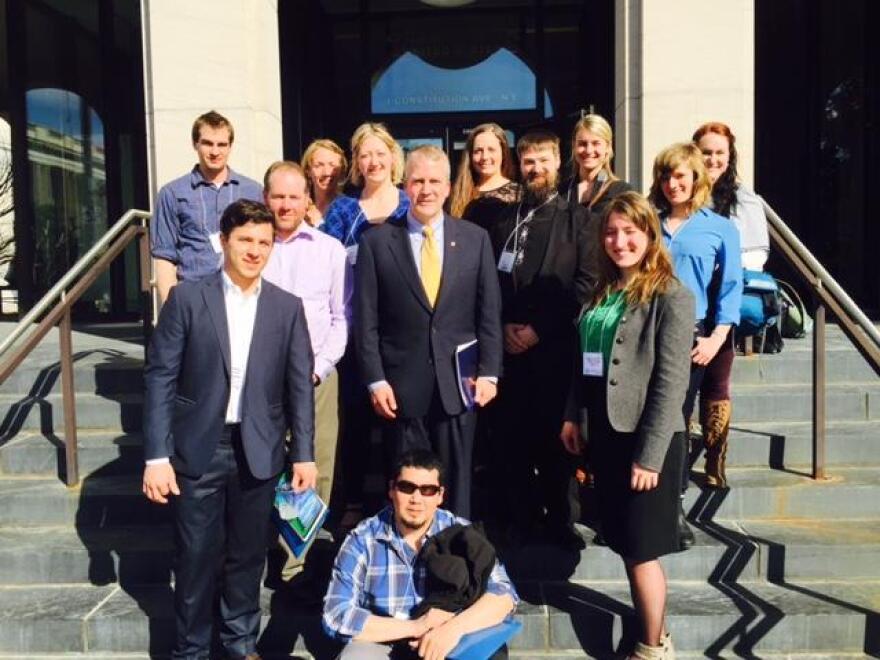During a whirlwind east coast tour this month, a group of young Alaska fishermen had the chance to visit the Boston Seafood Show, participate in Slow Fish in New Orleans, and share their concerns with Alaska’s congressional delegations.
For Bristol Bay drifter Michael Shangin, of Port Heiden, the most memorable part of his first east coast trip was running through the nation’s capital with Sen. Lisa Murkowski.
“We actually got to go watch Lisa speak on the Senate floor,” Shangin said. “She took us through underground tunnels and the senator’s subway – we had like 12 people crammed up in the little trolley – and she set us in her family booth, which I thought was pretty cool.”
Murkowski’s speech that day was about drug addictions and the challenges Alaskans face in accessing recovery programs. Shangin said it rang true to what he’s seen in the region.
Naknek’s Mili Vukich, another Bristol Bay drifter, said that sort of access characterized much of the trip, including the stop in Washington D.C.
In D.C., the participants worked together to figure out what message they could share with Alaska’s congressional delegation that they all agreed on, and learned how to effectively approach policy-makers, she said.
“We ended up being pretty united on, we want access for younger people into fisheries,” Vukich said. “I definitely agree that for the rest of the United States and Alaska, it should be more accessible – and a little easier to get loans and funding to get in the fishery. So we were really united on that front.”
That message was well-received, and a staffer for Murkowski even asked questions that helped them think about what specifically could improve fisheries access, and how they could most effectively advocate for it, Vukich said.
She and Shangin were two of ten fishermen who participated in the east coast tour organized by the Alaska Marine Conservation Council. Vukich said each stop was an opportunity to learn more about Alaska’s fisheries, the industry at large, and even how to work together more effectively.
Aside from the D.C. visit, both Shangin and Vukich said the enjoyed learning more about other fisheries and interacting with other fishermen.
Vukich said she doesn’t get as much opportunity to spend time with young fishermen in Naknek, and enjoyed that aspect of the trip. In Boston, the group also met with other young fishermen to hear about their experiences on the east coast.
“It’s really cool being able to be around other fishermen who are just as passionate as I am about being a fishermen and learning about fishing policy and learning what we can do to make it better,” she said.
At the seafood show, Vukich said there was lots to learn about, but she approached it with an eye toward improving the direct marketing effort she’s undertaken to help sell her family’s salmon in the Lower 48 states. She came to the realization that a high quality product with a story behind it might be the strongest selling point for Bristol Bay sockeye.
Shangin is a Bristol Bay drifter who grew up seining in the Chigniks, and has participated in a wide-range of other commercial fisheries in the state: putting out pots for crab, longlining for halibut, and seining for herring. The trip still taught him quite about fisheries elsewhere in the country, he said.
At the Slow Fish conference in New Orleans, he learned an unexpected fact.
“There’s still people out in the world that use trap fisheries and I thought that was gone a long time ago,” he said.
Shangin also shared his own fishing experiences there, offering those outside of Alaska a glimpse at some western Alaska fisheries. In Boston, he said he got a better sense of how Alaska fits in to the bigger fisheries scene.
“I’ve learned that Alaska is just a small key player in the seafood industry,” he said. “I was at the Boston seafood show and there was things in this world I never thought I would see. It was so huge, and we think in Alaska that we’re big key players in the game, we’re wrong. It’s a big industry out in the world. It’s pretty amazing to experience, to see what’s actually happening out there. Just mind-boggling.”

